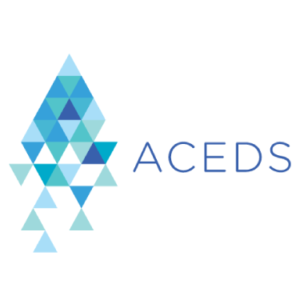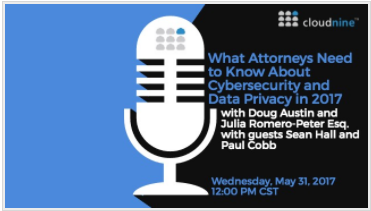eDiscoveryDaily
Sedona Conference Commentary on Proportionality, Third Edition: eDiscovery Trends
Within the first two months of this blog, way back in 2010, we posted a blog post about the original Commentary on Proportionality in Electronic Discovery from The Sedona Conference® (TSC), which is a project of The Sedona Conference Working Group on Electronic Document Retention & Production (WG1). Now, the third iteration of the Commentary has just been published.
WG1 commissioned a diverse drafting team in 2015 to study the changes to the Federal Rules of Civil Procedure and collaborate on an update to the Commentary that would reflect “the significant and evolving emphasis on proportionality” under the 2015 amendments. The Commentary delineates reasonable guidance on the application of proportionality standards that should enable common sense discovery practices and further the objective of the rules.
The public comment version of this third iteration of the Commentary was published in November 2016. Numerous comments were received by the close of the public comment period on January 31, 2017 and, where appropriate, were incorporated into the final version.
The core of the Commentary are the six Principles of Proportionality intended to provide a framework for the application of the doctrine of proportionality to all aspects of electronic discovery. These common-sense principles are (content in blue is changed since the original version, which we covered here):
- The burdens and costs of preservation of potentially relevant information should be weighed against the potential value and uniqueness of the information when determining the appropriate scope of preservation.
- Discovery should focus on the needs of the case and generally be obtained from the most convenient, least burdensome, and least expensive sources.
- Undue burden, expense, or delay resulting from a party’s action or inaction should be weighed against that party.
- The application of proportionality should be based on information rather than speculation.
- Nonmonetary factors should be considered when evaluating the burdens and benefits of discovery.
- Technologies to reduce cost and burden should be considered in the proportionality analysis.
The amendments to Rules 26(b)(1) and 37(e) in December 2015 were intended to modify how civil litigation is handled going forward. The committee notes made clear the increased emphasis on the role of proportionality in discovery. The practical ramifications of including the proportionality factors in the scope of discovery are evolving and many questions remain concerning how practitioners and judges will adjust. Those questions became the main drivers behind the initiative to revisit, and ultimately publish, the Third Edition of the Commentary.
The prepublication edition of The Sedona Conference Commentary on Proportionality in Electronic Discovery is available for download here.
So, what do you think? Have you encountered any cases where proportionality of discovery requests are at issue? Please share any comments you might have or if you’d like to know more about a particular topic.

Disclaimer: The views represented herein are exclusively the views of the author, and do not necessarily represent the views held by CloudNine. eDiscovery Daily is made available by CloudNine solely for educational purposes to provide general information about general eDiscovery principles and not to provide specific legal advice applicable to any particular circumstance. eDiscovery Daily should not be used as a substitute for competent legal advice from a lawyer you have retained and who has agreed to represent you.
Law Firm Sues Insurer Over $700K in Lost Billings Due to Ransomware Attack: eDiscovery Trends
Ransomware attacks, and what to do about them is one of the topics we’ll be discussing at our webcast on Wednesday, May 31. For more info on where to register, click here.
A small Rhode Island law firm has filed a lawsuit against its insurance company after the insurer refused to pay $700,000 in lost billings following a ransomware attack on the firm that locked down the firm’s computer files for three months.
According to the Providence Journal (‘Ransomware’ locks down prominent Providence law firm, written by Katie Mulvaney), Moses Afonso Ryan Ltd. is suing its insurer, Sentinel Insurance Co., for breach of contract and bad faith after it denied its claim for lost billings over the three-month period the documents were frozen last year by the so-called “ransomware” attack.
According to the suit, Moses Afonso Ryan’s computers became infected with the ransomware virus last year as a result of a lawyer clicking on an email attachment. The virus disabled the firm’s computer network, along with all of the documents and information on the network. As a result, lawyers and staffers “were rendered essentially unproductive,” according to the suit.
The firm ultimately agreed to pay the cybercriminals the $25,000 ransom in bitcoins, cyber currency that is virtually impossible to trace, to unlock its files. However, the process took three months as the firm negotiated the terms, established a bitcoin account and had to re-negotiate the deal and pay additional bitcoins after the first set of decryption tools failed to work.

During this data seizure period, the firm alleges its 10 attorneys were left unproductive, resulting in a loss of $700,000 in billings to the firm.
In its answer to the complaint, Sentinel denies an unjustified refusal to provide coverage under the law firm’s business owner’s policy and says it has paid the law firm the policy maximum of $20,000 for losses caused by computer viruses, which are covered under a computers and media endorsement. The insurer says it has no legal obligation to cover other ransomware losses. The firm’s loss in business income does not meet its policy requirements, according to Sentinel.
A copy of the suit filed by Moses Afonso Ryan and the answer filed by Sentinel are available from ABA Journal.
So, what do you think? Do you know how to protect yourself from a ransomware attack? Please share any comments you might have or if you’d like to know more about a particular topic.
Ransom Image Copyright © Touchstone Pictures

Disclaimer: The views represented herein are exclusively the views of the author, and do not necessarily represent the views held by CloudNine. eDiscovery Daily is made available by CloudNine solely for educational purposes to provide general information about general eDiscovery principles and not to provide specific legal advice applicable to any particular circumstance. eDiscovery Daily should not be used as a substitute for competent legal advice from a lawyer you have retained and who has agreed to represent you.
Here’s an Opportunity to Learn More About Data Discovery, Legal Discovery and Where CloudNine Fits in Both: eDiscovery Trends
Let’s face it, in this era of Big Data, more data is being created than ever before, from more sources than ever before, for organizations to manage and potentially use in litigation, investigations and audits. Thanks to our friends at ACEDS, you can learn more about these Data Discovery and Legal Discovery challenges today and how CloudNine addresses those challenges.
Today’s ACEDS webinar at noon CT (1pm ET, 10am PT) is titled Data, Discovery, and Decisions: Extending and Enhancing Legal Discovery. This is a one-hour session that I will be conducting that is part presentation and part demonstration, including a couple of new modules we’ve recently introduced at CloudNine.
Presentation Highlights:
- The Objectives of Data Discovery and Legal Discovery
- A Framework for Approaching Discovery
- Tasks and Tools For Effective Discovery
Demonstration Highlights:
- CloudNine eDiscovery Platform (Upload/Process/Review/Produce)
- NEW: Outpost from CloudNine: Data Transfer into Relativity
- NEW: CloudNine Legal Hold Notification
If you want an opportunity to learn a lot more about CloudNine and how we address today’s challenges in data and legal discovery, this webinar is for you! To sign up for today’s webcast, click here. Hope to see you there!
So, what do you think? Do you feel overwhelmed by the challenges presented by Big Data today and how to address them to meet your litigation needs? If so, please feel free to join us! And, as always, please share any comments you might have or if you’d like to know more about a particular topic.

Disclaimer: The views represented herein are exclusively the views of the author, and do not necessarily represent the views held by CloudNine. eDiscovery Daily is made available by CloudNine solely for educational purposes to provide general information about general eDiscovery principles and not to provide specific legal advice applicable to any particular circumstance. eDiscovery Daily should not be used as a substitute for competent legal advice from a lawyer you have retained and who has agreed to represent you.
Here’s a Chance to Learn What You Need to Know About Cybersecurity and Data Privacy in 2017: eDiscovery Best Practices
You’ve heard the horror stories. Maybe even experienced them yourselves. Data breaches are happening within organizations at an alarming rate, and sensitive data is being compromised regularly. As an attorney, what can you do to protect yourself, your firm and your client from becoming a victim? And, what do you need to do to keep up with ever-changing requirements for data security, both within the US and internationally?
On Wednesday, May 31 at noon CST (1:00pm EST, 10:00am PST), CloudNine, along with our friends, the cybersecurity experts at Firm Guardian, LLC, will conduct the webcast What Attorneys Need to Know About Cybersecurity and Data Privacy in 2017. This one-hour webcast will discuss what you need to know today about cybersecurity and data privacy to protect the sensitive data that your organization manages every day. Examples of topics being discussed include:
- The State of Cybersecurity in the U.S. in 2017
- Top Threats Facing Your Practice
- Your Responsibility to Your Clients: The High Cost of Data Leaks
- How to Protect Your Firm and Your Clients
- Recent Developments in International Data Privacy
- Criteria for Evaluating Providers in Your eDiscovery Projects
- Ethics Considerations
- Looking Forward: The Future of Cybersecurity in the Legal Field
I’ll be presenting the webcast, along with Julia Romero Peter, General Counsel and VP of Sales at CloudNine and joining us from Firm Guardian will be Sean Hall, CEO at Firm Guardian and Paul Cobb, the company’s COO. The Firm Guardian team has over 30 years of combined experience dealing with foreign and domestic cyber-threats against government and military targets. So, they have a lot of good information to share to help your organization combat those threats!
To register for the webcast, click here. Don’t be this firm.
Also, I will be in Chicago on Tuesday, May 23 for the Chicago leg of The Master’s Conference. The conference will be held at the Wyndham Grand Chicago Riverfront at 71 E Upper Wacker Dr., Chicago, IL 60601. If you’re going to be in Chicago that day (or close enough to come in for it), you can register here for the full day event (or attend for just half a day, if that’s all your schedule permits). I will be moderating a panel discussion on Data, Discovery, and Decisions: Extending Discovery From Collection To Creation, at 1:45pm on that day, with panelists Matthew C. Wolfe, Attorney with Shook, Hardy & Bacon, LLP, Ryan Tilot, Counsel, eDiscovery and Information Governance with Seyfarth Shaw and Mykhaylo Bulyk, Manager, Cyber Intelligence & Incident Response with CDK Global. If you’re in Chicago, hope to see you there!
So, what do you think? Do cybersecurity and data privacy concerns keep you up at night? Please share any comments you might have or if you’d like to know more about a particular topic.

Disclaimer: The views represented herein are exclusively the views of the author, and do not necessarily represent the views held by CloudNine. eDiscovery Daily is made available by CloudNine solely for educational purposes to provide general information about general eDiscovery principles and not to provide specific legal advice applicable to any particular circumstance. eDiscovery Daily should not be used as a substitute for competent legal advice from a lawyer you have retained and who has agreed to represent you.
Court Determines TAR Without Keyword Search Culling First is Preferable: eDiscovery Case Law
In FCA US, LLC v. Cummins, Inc., No. 16-12883 (E.D. Mich., Mar. 28, 2017), Michigan District Judge Avern Cohn “rather reluctantly” decided a dispute between the plaintiff and defendant on whether the universe of electronic material subject to Technology Assisted Review (TAR) review should first be culled by the use of search terms by agreeing with the plaintiff that “[a]pplying TAR to the universe of electronic material before any keyword search reduces the universe of electronic material is the preferred method.”
Case Background
In this dispute over the allocation of the cost incurred for an auto part that became the subject of a recall, the parties agreed on many issues relating to discovery and particularly electronic discovery. However, one issue that they couldn’t agree on was whether the universe of electronic material subject to TAR review should first be culled by the use of search terms. The plaintiff took the position that the electronic material subject to TAR review should not first be culled by the use of search terms, while the defendant took the position that a pre-TAR culling is appropriate.
Judge’s Ruling
Noting that the Court decides “rather reluctantly” to rule on the issue, Judge Cohn stated:
“Given the magnitude of the dispute and the substantial matters upon which they agree, the parties should have been able to resolve the discovery issue without the Court as decision maker. Be that as it may, having reviewed the letters and proposed orders together with some technical in-house assistance including a read of The Sedona Conference TAR Case Law Primer, 18 Sedona Con. J. ___ (forthcoming 2017), the Court is satisfied that FCA has the better postion (sic). Applying TAR to the universe of electronic material before any keyword search reduces the universe of electronic material is the preferred method. The TAR results can then be culled by the use of search terms or other methods.”
As a result, Judge Cohn agreed to enter the plaintiff’s proposed order regarding the TAR approach.
So, what do you think? Should TAR be performed with no pre-search culling beforehand? Should courts rule on a preferred TAR approach? Please share any comments you might have or if you’d like to know more about a particular topic.

Disclaimer: The views represented herein are exclusively the views of the author, and do not necessarily represent the views held by CloudNine. eDiscovery Daily is made available by CloudNine solely for educational purposes to provide general information about general eDiscovery principles and not to provide specific legal advice applicable to any particular circumstance. eDiscovery Daily should not be used as a substitute for competent legal advice from a lawyer you have retained and who has agreed to represent you.
Court Approves Defendant’s Proposed Random Sampling Production Plan: eDiscovery Case Law
In Duffy v. Lawrence Memorial Hospital, No. 14-2256 (D. Kansas, Mar. 31, 2017), Kansas Magistrate Judge Teresa J. James granted the Motion to Modify Discovery Order from the defendant (and counterclaimant), where it asked the Court to enter a protective order directing it to produce a random sampling of 252 patient records, along with five spares, in order to respond to the plaintiff/relator’s document requests.
Case Background
In this case, the plaintiff alleged that the defendant submitted false information to the government to maximize reimbursement for federal medical care programs; in turn, the defendant counterclaimed for breach of contract and fraud. In a February 2017 order, the Court ordered the defendant to produce documents responsive to certain plaintiff requests in her Second Request for Production of Documents within 14 days. Defendant produced the most of the requested documents, except for those associated with four requests that were the subject of an instant motion.
As the defendant conducted searches for documents responsive to these requests, it determined that 15,574 unique patient records would have to be located and gathered. In an effort to calculate the time necessary to locate and produce the relevant patient records, the defendant’s Medical Records department obtained a sample of ten patient records and determined that it would take 30 minutes per record to process and review the records to respond to the four RFP requests. As a result, the defendant estimated that it would take 7,787 worker hours to locate and produce responsive information for 15,574 patient records, at a cost of $196,933.23. Redaction of patients’ personal confidential information would take another ten reviewers and one quality control attorney fourteen days at a cost of $37,259.50. So, the total cost to produce information relevant to the RFPs was estimated to be over $230,000.
Given these costs, the defendant asked the Court to modify its order by limiting the required production to a random sampling of 252 patient records plus five spares, using a statistical tool known at RAT-STATS used by the Department of Health and Human Services Office of Inspector General to randomly select the patient records. The plaintiff objected, claiming that the defendant did not attempt to meet and confer and also because the Court had already rejected the defendant’s previous contention of undue burden. The plaintiff also argued that redaction was unnecessary because a protective order was in place to designate the patient info as confidential information.
Judge’s Ruling
With regard to the previous rejection of undue burden, Judge James stated: “Had Defendant presented such evidence in response to Plaintiff’s Motion to Compel, the Court may have found the requests at issue unduly burdensome and disproportional to the needs of the case. Contrary to Plaintiff’s assertion, Defendant did not waive its right to seek protection once the enormity of the task became apparent.” As for the plaintiff’s objection that the defendant did not meet and confer beforehand, Judge James noted that the “parties conferred following Defendant’s objections to the discovery requests, and that was the point at which some meeting of the minds could have produced a different response by Defendant or an alteration of the discovery request by Plaintiff. At this point, however, Defendant is seeking relief from this Court’s order rather than from a party’s discovery request.”
As a result, Judge James stated: “The Court will modify its order (ECF No. 133) to direct Defendant to utilize RAT-STATS and produce a random sampling of 252 patient records, along with five spares, to respond to RFP Nos. 40, 41, 43 and 58.” She also directed the defendant to use RAT-STATS (as requested) to randomly select the patient records to be produced and sided with the defendant to redact personal confidential information from the patient records that “Defendant has a legal duty to safeguard.”
So, what do you think? Is random sampling an appropriate option for cases where production of a larger set may be an undue burden? Please share any comments you might have or if you’d like to know more about a particular topic.

Disclaimer: The views represented herein are exclusively the views of the author, and do not necessarily represent the views held by CloudNine. eDiscovery Daily is made available by CloudNine solely for educational purposes to provide general information about general eDiscovery principles and not to provide specific legal advice applicable to any particular circumstance. eDiscovery Daily should not be used as a substitute for competent legal advice from a lawyer you have retained and who has agreed to represent you.
Do We Have a Confidence “Spring” in Our Step in 2017?: eDiscovery Trends
The results are in from the Complex Discovery Spring 2017 eDiscovery Business Confidence Survey, which has just concluded and (as was the case for the 2016 Winter, Spring, Summer and Fall surveys and the 2017 Winter survey) the results are published on Rob Robinson’s terrific Complex Discovery site. How confident are individuals working in the eDiscovery ecosystem in the business of eDiscovery? Let’s see.
As always, Rob provides a complete breakdown of the latest survey results, which you can check out here. So, to avoid redundancy, I will primarily focus on trends over the past four surveys to see how the responses have varied from quarter to quarter and will take a look at a year over year comparison to the Spring 2016 survey.
The Spring 2017 Survey response period was initiated on April 17, and continued until registration of 100 responses on May 3 (this survey was capped at 104). Rob notes that this limiting of responders to 100 (or so) individuals is designed to create linearity in the number of responses for each quarterly surveySo, in the future, if you want your voice heard, respond early!
Percentage of Provider Respondents Continuing to Rise: Of the types of respondents, 58.6% were either Software and/or Services Provider (44.2%) or Consultancy (14.4%) for over half of respondents as some sort of outsourced provider (over half of total respondents – I’m counting law firm respondents as consumers even though they can also be providers as well). Law firm respondents comprised a majority of the remaining respondents with 30.8%. Corporate responders were a distant fourth with 4.8% of respondents; no other type of respondents was over 3%. Here’s a graphical representation of the trend over the past four quarters:
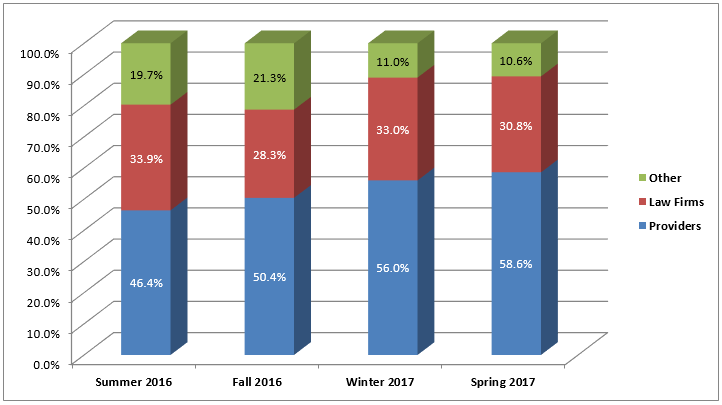
When comparing this year’s Winter survey to last year’s survey, it is clear that (despite the continued trend toward a rise in percentage of provider respondents), the survey is (barely) still more diverse than it was a year ago, especially with regard to the percentage of law firm respondents:
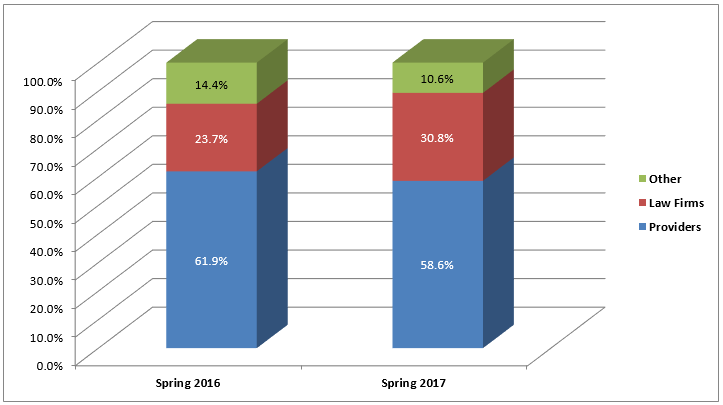
Just Over Half of Respondents Consider Business to Be Good: Over half (52.9%, to be exact) of respondents rated the current general business conditions for eDiscovery in their segment to be good, with only 6.7% rating business conditions as bad. Last quarter, those numbers were 49% and 9% respectively, so this quarter reflects more bullish than last quarter, continuing the trend of up and down quarter over quarter. Will the summer mean another downturn? We’ll see. Here is the trend for the last four quarterly surveys:
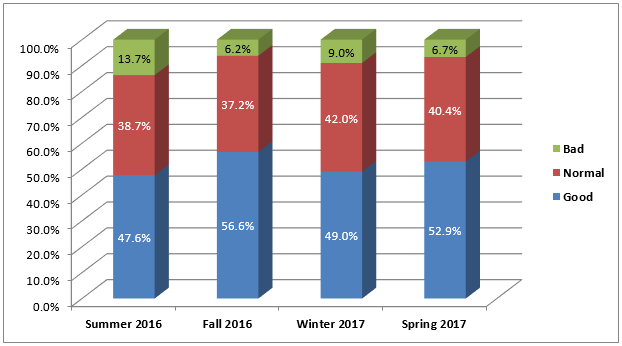
When comparing against last year’s Winter survey, respondents this Spring aren’t as bullish as they were a year ago (over 60% rated the current general business conditions for eDiscovery in their segment to be good in 2016). Of course, the survey was smaller and more provider-centric back then (for what it’s worth):
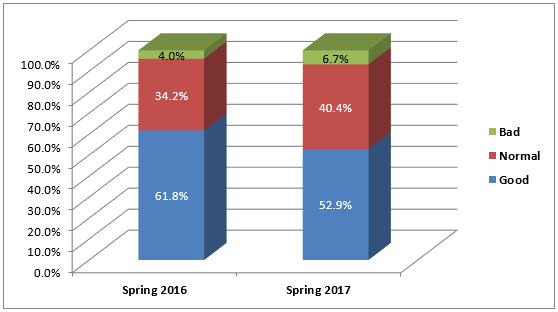
Almost Everyone Still Expects eDiscovery Business Conditions to be as Good or Better Six Months From Now: Almost all respondents (96.2%) expect business conditions will be in their segment to be the same or better six months from now (well above last quarter’s 86%), and the percentage expecting business to be better jumped back up to 47.1%. Revenue (at combined 93.3% for the same or better) and profit (combined 93.3%) also rose from last quarter (for the first time ever, half of respondents expect higher profits in six months). Here is the profits trend for the last four quarterly surveys:
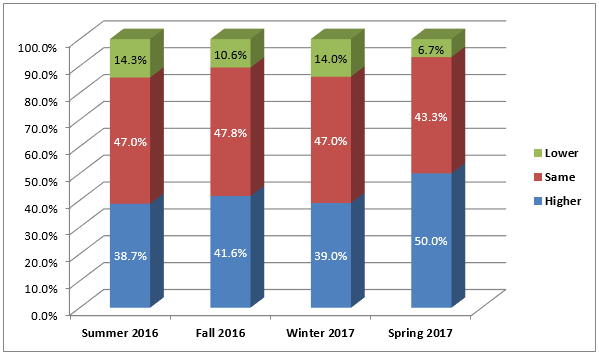
When compared against last year’s Winter survey, the distribution for profits six months from now was way more bullish with a 10.5% increase of respondents expecting higher profits and a 2.5% decrease of respondents expecting lower profits:
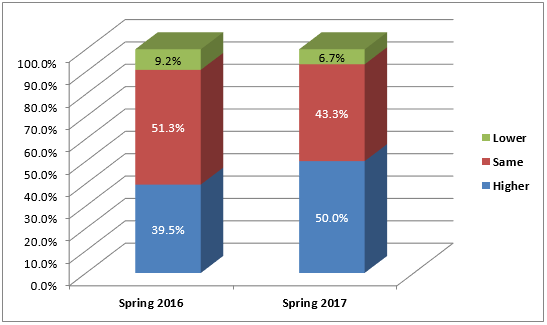
Increasing Volumes of Data is Still Most Impactful to eDiscovery Business: Increasing Volumes of Data was the top impactful factor to the business of eDiscovery over the next six months at 25%, with Budgetary Constraints next up at 21.2%. Lack of Personnel was close behind in third with 20.2%, followed by Data Security (16.3%), Increasing Types of Data (10.6%) and Inadequate Technology (at 6.7%) bringing up the rear. The graph below illustrates the distribution across the most recent four quarterly surveys.
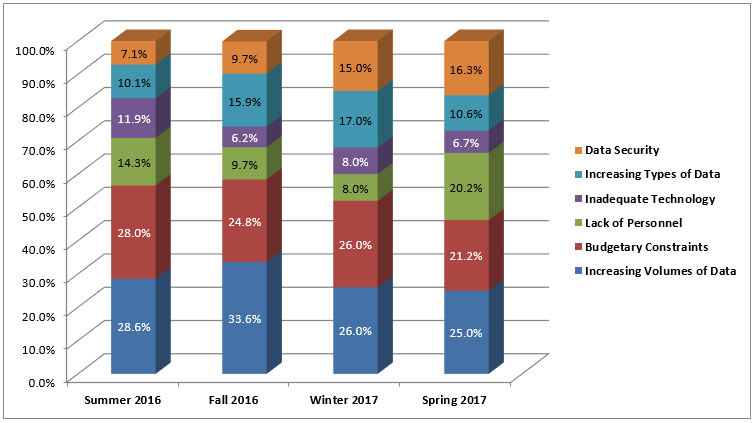
A year ago, Budgetary Constraints was voted as the most impactful to eDiscovery business, but ever since then, Increasing Volumes of Data has been first or tied for first, so it’s a clear consistent impact on eDiscovery business these days:
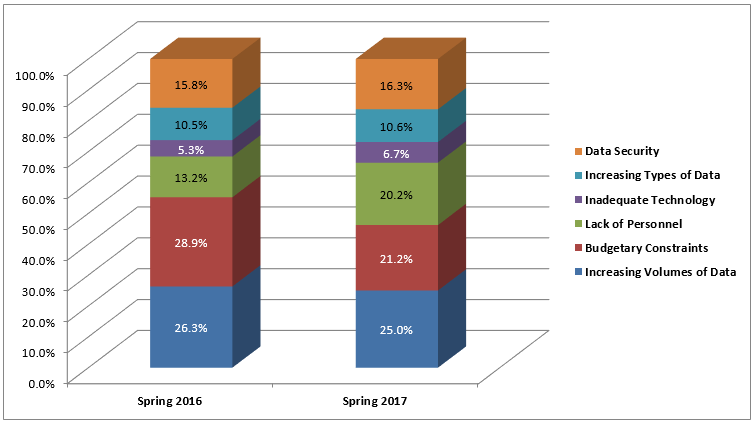
Executive Leader Respondents Moving Back Up: Last time, the three groups of respondents were fairly balanced. This time, Executive Leadership respondents rose again (to 44.2%) and was the clear leader, with Operational Management and Tactical Execution splitting the remaining respondents (at 27.9% each). Here’s the breakdown of the last four quarters:
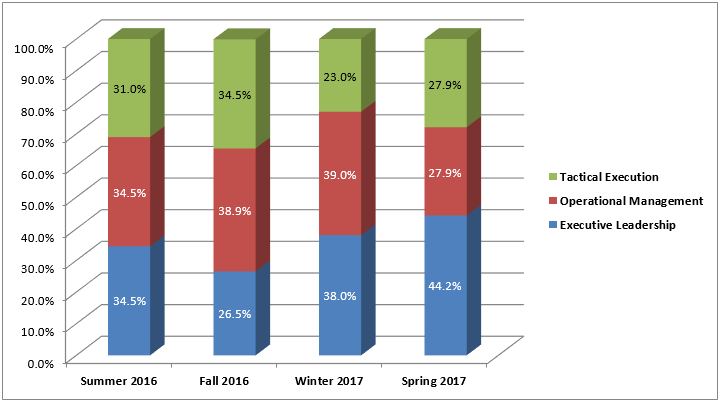
Nonetheless, the survey is certainly more distributed than last year, where Executive Leadership was a majority of the responses. It will be interesting to see what the distribution is in the Summer survey.
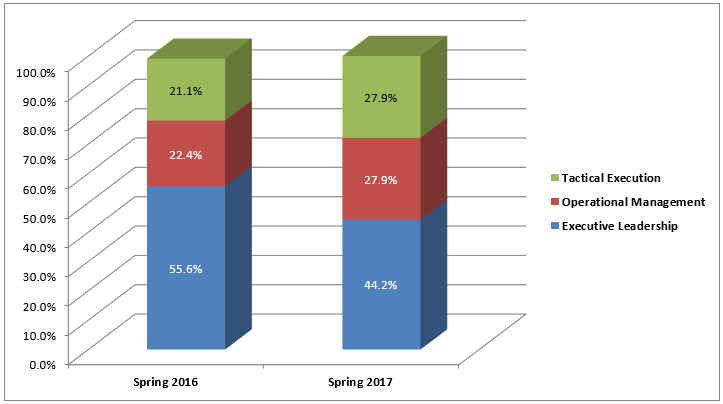
Again, Rob has published the results on his site here, which shows responses to additional questions not referenced here. Check it out.
So, what do you think? What’s your state of confidence in the business of eDiscovery? Please share any comments you might have or if you’d like to know more about a particular topic.

Disclaimer: The views represented herein are exclusively the views of the author, and do not necessarily represent the views held by CloudNine. eDiscovery Daily is made available by CloudNine solely for educational purposes to provide general information about general eDiscovery principles and not to provide specific legal advice applicable to any particular circumstance. eDiscovery Daily should not be used as a substitute for competent legal advice from a lawyer you have retained and who has agreed to represent you.
Corporate Counsel Best of 2017 Survey Results: eDiscovery Trends
Last year, we covered the inaugural Best of Corporate Counsel Survey of the top providers to the in-house corporate legal marketplace in July. This year, Corporate Counsel apparently decided to move it up a bit as, on Monday, it released its Corporate Counsel Best of 2017 results, which (once again) include rankings in a few litigation support and eDiscovery categories.
As they note in their introductory letter, Corporate Counsel Best of 2017 highlights the businesses and individuals who garnered the most votes from members of the in-house legal community. Voting was conducted via online ballot and limited to those working within in-house corporate legal and compliance departments. Once again, the ballot consisted of 55 categories and over 1,500 votes were cast.
The survey results start here and span eighteen(!) pages with advertisements interspersed throughout. Here are the results of some of the notable eDiscovery categories:
END-TO-END LITIGATION CONSULTING FIRM
- RVM
- CloudNine Discovery
- Elite Document Technology
END-TO-END E-DISCOVERY PROVIDER
- Elite Document Technology
- RVM
- CloudNine Discovery
TECHNOLOGY ASSISTED REVIEW E-DISCOVERY SOLUTION
- RVM
- Elite Document Technology
- CloudNine Discovery
DATA & TECHNOLOGY MANAGEMENT E-DISCOVERY PROVIDER
- RVM
- Elite Document Technology
- CloudNine Discovery
DATA RECOVERY SOLUTION PROVIDER
- RVM
- Ernst & Young, LLP AND Kroll Ontrack
- BDO Consulting
- Legal Hold Pro by Zapproved
- Exterro Legal Services
- Relativity Legal Hold
- Elite Document Technology
- RVM
- Ernst & Young LLP
MANAGED E-DISCOVERY & LITIGATION SUPPORT SERVICE PROVIDER
- RVM AND Elite Document Technology
- CloudNine Discovery
- BDO Consulting
- Elite Document Technology
- Relativity by kCura
- CloudNine Discovery
- Exterro
- CasePoint for iPad
- APPlied Mobile (LexisNexis Applied Discovery)
- Elevate
- Epiq
- Discover Ready
INFORMATION GOVERNANCE SOLUTION
- RVM
- PwC
- CloudNine Discovery
PREDICTIVE CODING E-DISCOVERY SOLUTION
- Elite Document Technology
- Druva
- FTI Consulting
LEGAL/LITIGATION SUPPORT STAFFING AGENCY
- Robert Half Legal
- DTI
- Special Counsel
So, what do you think? Do you agree with the selections or do you have a different favorite provider in any of these categories? Please share any comments you might have or if you’d like to know more about a particular topic.

Disclaimer: The views represented herein are exclusively the views of the author, and do not necessarily represent the views held by CloudNine. eDiscovery Daily is made available by CloudNine solely for educational purposes to provide general information about general eDiscovery principles and not to provide specific legal advice applicable to any particular circumstance. eDiscovery Daily should not be used as a substitute for competent legal advice from a lawyer you have retained and who has agreed to represent you.
SCOTUS Reverses and Remands Circuit Court Award of Fees for Discovery Misconduct: eDiscovery Case Law
In Goodyear Tire & Rubber Co. v. Haeger, 581 U.S. ___ (2017), the Supreme Court of the United States, in a decision delivered by Justice Kagan reversed and remanded the decision by the US Court of Appeals, Ninth Circuit, for further proceedings, stating that “because the court here granted legal fees beyond those resulting from the litigation misconduct, its award cannot stand.”
Case Background
In this product liability case, the plaintiffs sued the defendant after their motorhome swerved off the road and flipped over, alleging the accident was caused by the failure of their Goodyear tire. During discovery, the plaintiffs repeatedly asked the defendant to turn over internal test results related to the tire at issue, but “the company’s responses were both slow in coming and unrevealing in content.” The parties eventually settled on the eve of trial, then, several months later, the plaintiffs’ counsel learned from a newspaper article that, in another lawsuit involving the tire at issue, it “got unusually hot” at certain speeds. The defendant conceded withholding the information from the plaintiffs even though they had frequently requested “all testing data” related to the tire. The plaintiffs sought sanctions for discovery fraud, in the form of payment of their “attorney’s fees and costs expended in the litigation.”
The District Court agreed to make such an award in the exercise of its inherent power to sanction litigation misconduct, and justified its authority to award a greater amount than the expenses caused by the offending behavior because the defendant’s “sanctionable conduct r[ose] to a truly egregious level.” Ultimately, the court awarded $2.7 million to account for Plaintiffs’ legal costs “since the moment, early in the litigation, when Goodyear made its first dishonest discovery response.” Acknowledging that the Ninth Circuit might require a link between the misconduct and the harm caused, however, the court also made a contingent award of $2 million. That smaller amount, designed to take effect if the Ninth Circuit reversed the larger award, deducted $700,000 in fees the plaintiffs incurred in developing claims against other defendants and proving their own medical damages. The Ninth Circuit affirmed the full $2.7 million award, concluding that the District Court had properly awarded the plaintiffs all the fees they incurred during the time when the defendant was acting in bad faith.
Court’s Ruling
The court noted that “Federal courts possess certain inherent powers, including ‘the ability to fashion an appropriate sanction for conduct which abuses the judicial process.’…One permissible sanction is an assessment of attorney’s fees against a party that acts in bad faith. Such a sanction must be compensatory, rather than punitive, when imposed pursuant to civil procedures.” In this case, “[n]either court used the correct legal standard. The District Court specifically disclaimed the need for a causal link on the ground that this was a ‘truly egregious’ case…And the Ninth Circuit found that the trial court could grant all attorney’s fees incurred ‘during the time when [Goodyear was] acting in bad faith,’…—a temporal, not causal, limitation. A sanctioning court must determine which fees were incurred because of, and solely because of, the misconduct at issue, and no such finding lies behind the $2.7 million award made and affirmed below.”
In reversing and remanding the decision, the Court stated: “Although the District Court considered causation in arriving at its back-up award of $2 million, it is unclear whether its understanding of that requirement corresponds to the appropriate standard—an uncertainty pointing toward throwing out the fee award and instructing the trial court to consider the matter anew. However, the Haegers contend that Goodyear has waived any ability to challenge the contingent award since the $2 million sum reflects Goodyear’s own submission that only about $700,000 of the fees sought would have been incurred regardless of the company’s behavior. The Court of Appeals did not address that issue, and this Court declines to decide it in the first instance. The possibility of waiver should therefore be the initial order of business on remand.”
So, what do you think? Should egregious behavior be subject to an award greater than the expenses incurred by the party affected by that behavior? Please share any comments you might have or if you’d like to know more about a particular topic.
Disclaimer: The views represented herein are exclusively the views of the author, and do not necessarily represent the views held by CloudNine. eDiscovery Daily is made available by CloudNine solely for educational purposes to provide general information about general eDiscovery principles and not to provide specific legal advice applicable to any particular circumstance. eDiscovery Daily should not be used as a substitute for competent legal advice from a lawyer you have retained and who has agreed to represent you.



